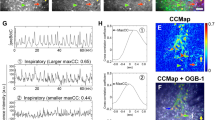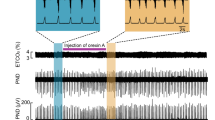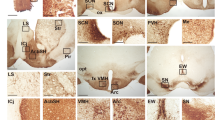Abstract
Inhibitory neurons make up a substantial fraction of the neurons in the preBötzinger complex (preBötC), a site that is critical for mammalian eupneic breathing. We investigated the role of glycinergic preBötC neurons in respiratory rhythmogenesis in mice using optogenetically targeted excitation and inhibition. Channelrhodopsin-2 (ChR2) or Archaerhodopsin (Arch) were expressed in glycinergic preBötC neurons of glycine transporter 2 (Glyt2, also known as Slc6a5)-Cre mice. In ChR2-transfected mice, brief inspiratory-phase bilateral photostimulation targeting the preBötC prematurely terminated inspiration, whereas expiratory-phase photostimulation delayed the onset of the next inspiration. Prolonged photostimulation produced apneas lasting as long as the light pulse. Inspiratory-phase photoinhibition in Arch-transfected mice during inspiration increased tidal volume without altering inspiratory duration, whereas expiratory-phase photoinhibition shortened the latency until the next inspiration. During persistent apneas, prolonged photoinhibition restored rhythmic breathing. We conclude that glycinergic preBötC neurons modulate inspiratory pattern and are important for reflex apneas, but that the rhythm can persist after substantial dampening of their activity.
This is a preview of subscription content, access via your institution
Access options
Subscribe to this journal
Receive 12 print issues and online access
$209.00 per year
only $17.42 per issue
Buy this article
- Purchase on Springer Link
- Instant access to full article PDF
Prices may be subject to local taxes which are calculated during checkout






Similar content being viewed by others
References
Tan, W. et al. Silencing preBotzinger complex somatostatin-expressing neurons induces persistent apnea in awake rat. Nat. Neurosci. 11, 538–540 (2008).
Smith, J.C., Ellenberger, H.H., Ballanyi, K., Richter, D.W. & Feldman, J.L. Pre-Botzinger complex: a brainstem region that may generate respiratory rhythm in mammals. Science 254, 726–729 (1991).
Winter, S.M. et al. Glycinergic interneurons are functionally integrated into the inspiratory network of mouse medullary slices. Pflugers Arch. 458, 459–469 (2009).
Stornetta, R.L. et al. A group of glutamatergic interneurons expressing high levels of both neurokinin-1 receptors and somatostatin identifies the region of the pre-Botzinger complex. J. Comp. Neurol. 455, 499–512 (2003).
Bouvier, J. et al. Hindbrain interneurons and axon guidance signaling critical for breathing. Nat. Neurosci. 13, 1066–1074 (2010).
Gray, P.A. et al. Developmental origin of preBotzinger complex respiratory neurons. J. Neurosci. 30, 14883–14895 (2010).
Koizumi, H. et al. Structural-functional properties of identified excitatory and inhibitory interneurons within pre-Botzinger complex respiratory microcircuits. J. Neurosci. 33, 2994–3009 (2013).
Richter, D.W. & Smith, J.C. Respiratory rhythm generation in vivo. Physiology (Bethesda) 29, 58–71 (2014).
Ballantyne, D. & Richter, D.W. Post-synaptic inhibition of bulbar inspiratory neurones in the cat. J. Physiol. (Lond.) 348, 67–87 (1984).
Janczewski, W.A., Tashima, A., Hsu, P., Cui, Y. & Feldman, J.L. Role of inhibition in respiratory pattern generation. J. Neurosci. 33, 5454–5465 (2013).
Morgado-Valle, C., Baca, S.M. & Feldman, J.L. Glycinergic pacemaker neurons in preBotzinger complex of neonatal mouse. J. Neurosci. 30, 3634–3639 (2010).
Deisseroth, K. et al. Next-generation optical technologies for illuminating genetically targeted brain circuits. J. Neurosci. 26, 10380–10386 (2006).
Chow, B.Y. et al. High-performance genetically targetable optical neural silencing by light-driven proton pumps. Nature 463, 98–102 (2010).
Lin, J.Y., Lin, M.Z., Steinbach, P. & Tsien, R.Y. Characterization of engineered channelrhodopsin variants with improved properties and kinetics. Biophys. J. 96, 1803–1814 (2009).
Chalphin, A.V. & Saha, M.S. The specification of glycinergic neurons and the role of glycinergic transmission in development. Front. Mol. Neurosci. 3, 11 (2010).
Cardin, J.A. et al. Driving fast-spiking cells induces gamma rhythm and controls sensory responses. Nature 459, 663–667 (2009).
Smith, J.C., Abdala, A.P., Koizumi, H., Rybak, I.A. & Paton, J.F. Spatial and functional architecture of the mammalian brain stem respiratory network: a hierarchy of three oscillatory mechanisms. J. Neurophysiol. 98, 3370–3387 (2007).
Shao, X.M. & Feldman, J.L. Respiratory rhythm generation and synaptic inhibition of expiratory neurons in pre-Botzinger complex: differential roles of glycinergic and GABAergic neural transmission. J. Neurophysiol. 77, 1853–1860 (1997).
Schreihofer, A.M., Stornetta, R.L. & Guyenet, P.G. Evidence for glycinergic respiratory neurons: Botzinger neurons express mRNA for glycinergic transporter 2. J. Comp. Neurol. 407, 583–597 (1999).
Jiang, C. & Lipski, J. Extensive monosynaptic inhibition of ventral respiratory group neurons by augmenting neurons in the Botzinger complex in the cat. Exp. Brain Res. 81, 639–648 (1990).
Ezure, K., Tanaka, I. & Kondo, M. Glycine is used as a transmitter by decrementing expiratory neurons of the ventrolateral medulla in the rat. J. Neurosci. 23, 8941–8948 (2003).
Alheid, G.F. & McCrimmon, D.R. The chemical neuroanatomy of breathing. Respir. Physiol. Neurobiol. 164, 3–11 (2008).
Dobbins, E.G. & Feldman, J.L. Brainstem network controlling descending drive to phrenic motoneurons in rat. J. Comp. Neurol. 347, 64–86 (1994).
Dobbins, E.G. & Feldman, J.L. Differential innervation of protruder and retractor muscles of the tongue in rat. J. Comp. Neurol. 357, 376–394 (1995).
Kam, K., Worrell, J.W., Ventalon, C., Emiliani, V. & Feldman, J.L. Emergence of population bursts from simultaneous activation of small subsets of preBötzinger complex inspiratory neurons. J. Neurosci. 33, 3332–3338 (2013).
Burns, B.D. The central control of respiratory movements. Br. Med. Bull. 19, 7–9 (1963).
Bradley, G.W., von Euler, C., Marttila, I. & Roos, B. A model of the central and reflex inhibition of inspiration in the cat. Biol. Cybern. 19, 105–116 (1975).
von Euler, C. On the central pattern generator for the basic breathing rhythmicity. J. Appl. Physiol. 55, 1647–1659 (1983).
Feldman, J.L. & Cowan, J.D. Large-scale activity in neural nets II: a model for the brainstem respiratory oscillator. Biol. Cybern. 17, 39–51 (1975).
Richter, D.W. Generation and maintenance of the respiratory rhythm. J. Exp. Biol. 100, 93–107 (1982).
Schmid, K., Foutz, A.S. & Denavit-Saubie, M. Inhibitions mediated by glycine and GABAA receptors shape the discharge pattern of bulbar respiratory neurons. Brain Res. 710, 150–160 (1996).
Xia, L., Damon, T., Niblock, M.M., Bartlett, D. & Leiter, J.C. Unilateral microdialysis of gabazine in the dorsal medulla reverses thermal prolongation of the laryngeal chemoreflex in decerebrate piglets. J. Appl. Physiol. 103, 1864–1872 (2007).
Curran, A.K., Xia, L., Leiter, J.C. & Bartlett, D. Jr. Elevated body temperature enhances the laryngeal chemoreflex in decerebrate piglets. J. Appl. Physiol. 98, 780–786 (2005).
Heman-Ackah, Y.D., Pernell, K.J. & Goding, G.S. The laryngeal chemoreflex: an evaluation of the normoxic response. Laryngoscope 119, 370–379 (2009).
Adamantidis, A.R., Zhang, F., Aravanis, A.M., Deisseroth, K. & de Lecea, L. Neural substrates of awakening probed with optogenetic control of hypocretin neurons. Nature 450, 420–424 (2007).
Gradinaru, V. et al. Targeting and readout strategies for fast optical neural control in vitro and in vivo. J. Neurosci. 27, 14231–14238 (2007).
Paxinos, G., Franklin, K.B.J. & Franklin, K.B.J. The Mouse Brain in Stereotaxic Coordinates (Academic Press, 2001).
Pagliardini, S. et al. Active expiration induced by excitation of ventral medulla in adult anesthetized rats. J. Neurosci. 31, 2895–2905 (2011).
Poyatos, I., Ponce, J., Aragon, C., Gimenez, C. & Zafra, F. The glycine transporter GLYT2 is a reliable marker for glycine-immunoreactive neurons. Brain Res. Mol. Brain Res. 49, 63–70 (1997).
Zeilhofer, H.U. et al. Glycinergic neurons expressing enhanced green fluorescent protein in bacterial artificial chromosome transgenic mice. J. Comp. Neurol. 482, 123–141 (2005).
McKay, L.C., Janczewski, W.A. & Feldman, J.L. Sleep-disordered breathing after targeted ablation of preBotzinger complex neurons. Nat. Neurosci. 8, 1142–1144 (2005).
Lewis, J., Bachoo, M., Polosa, C. & Glass, L. The effects of superior laryngeal nerve stimulation on the respiratory rhythm: phase-resetting and aftereffects. Brain Res. 517, 44–50 (1990).
Acknowledgements
The authors thank G. Li for excellent technical work and N. Brecha, T. Otis and K. Kam for thoughtful discussion. This work was supported by US National Institutes of Health grants NS72211 and NS58280.
Author information
Authors and Affiliations
Contributions
D.S. and J.L.F. conceived of the study and designed the experiments. D.S. performed the experiments with help from J.W.W. and Y.C., and D.S. and J.W.W. analyzed the data. D.S. and J.L.F. made the figures and wrote the manuscript with help from J.W.W.
Corresponding author
Ethics declarations
Competing interests
The authors declare no competing financial interests.
Supplementary information
Rights and permissions
About this article
Cite this article
Sherman, D., Worrell, J., Cui, Y. et al. Optogenetic perturbation of preBötzinger complex inhibitory neurons modulates respiratory pattern. Nat Neurosci 18, 408–414 (2015). https://doi.org/10.1038/nn.3938
Received:
Accepted:
Published:
Issue Date:
DOI: https://doi.org/10.1038/nn.3938
This article is cited by
-
Parabrachial tachykinin1-expressing neurons involved in state-dependent breathing control
Nature Communications (2023)
-
How the brain plays musical statues
Nature Neuroscience (2023)
-
Hippocampal ensemble dynamics and memory performance are modulated by respiration during encoding
Nature Communications (2023)
-
Molecularly defined circuits for cardiovascular and cardiopulmonary control
Nature (2022)
-
Transcriptomes of electrophysiologically recorded Dbx1-derived respiratory neurons of the preBötzinger complex in neonatal mice
Scientific Reports (2022)



